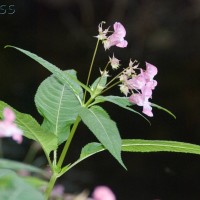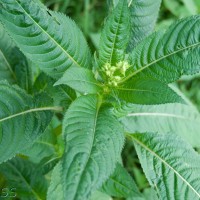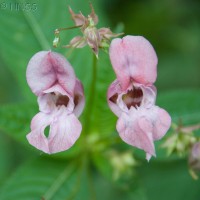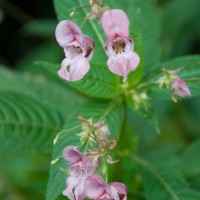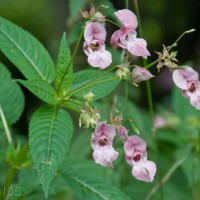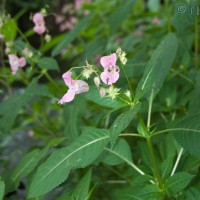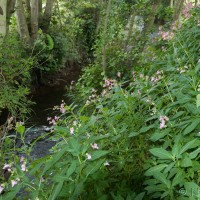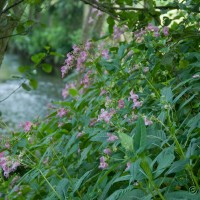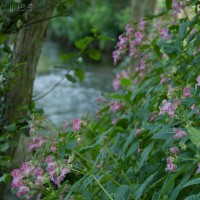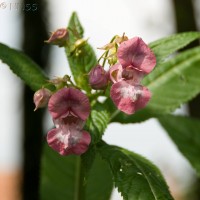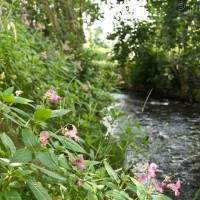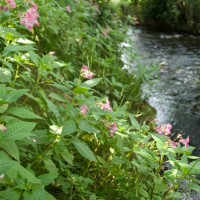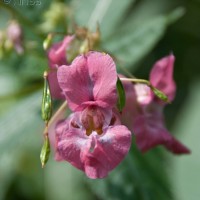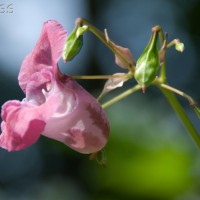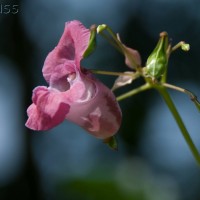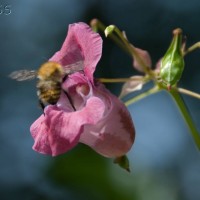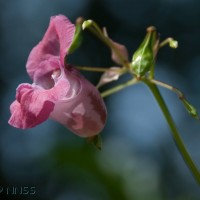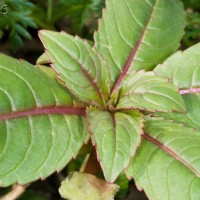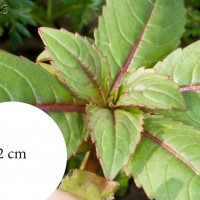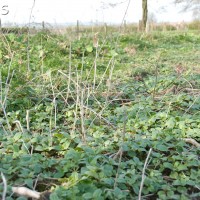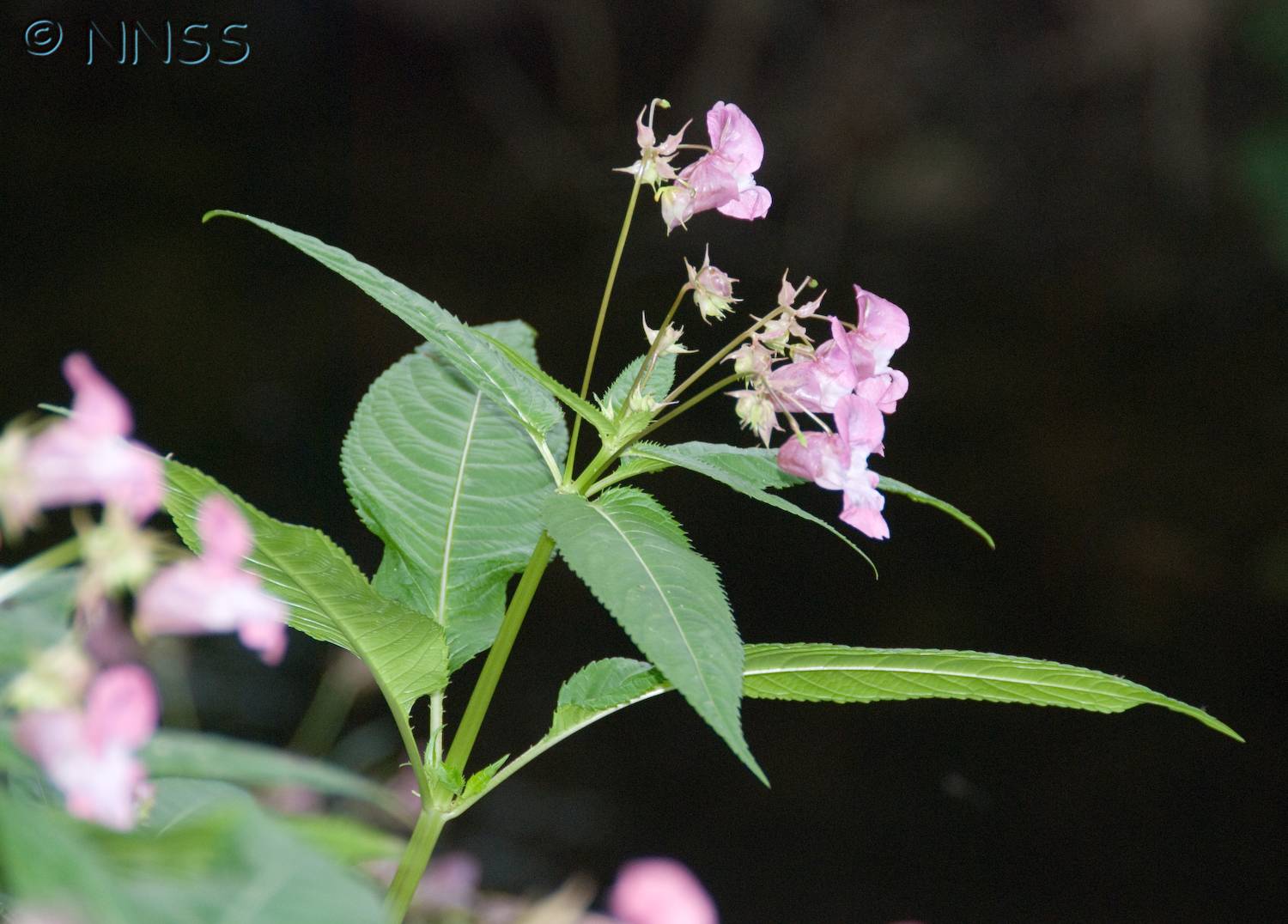
Himalayan Balsam - Impatiens glandulifera
Expand and collapse the sections below by clicking on the title or + / - icons.
Short description of Impatiens glandulifera, Himalayan Balsam
Glabrous annual herb with stout succulent, reddish-translucent hollow stems to 2.5 m; leaves opposite or in whorls of 3, 5-18 cm long and 3-7 cm wide; flowers with short spur, helmeted upper petal, deep purplish-pink to white, strong balsam smell.
Impact summary: Impatiens glandulifera, Himalayan Balsam
Impact is high in Great Britain. It is rapid-spreading on soft banks of waterbodies, dominant, forming extensive monoculture stands to the exclusion of most other plants.
Habitat summary: Impatiens glandulifera, Himalayan Balsam
Moist and semi-shaded damp places, predominant on banksides by slow-moving watercourses.
Overview table
| Environment | Terrestrial |
|---|---|
| Species status | Non-Native |
| Native range | Himalayas |
| Functional type | Land plant |
| Status in England | Non-Native |
| Status in Scotland | Non-Native |
| Status in Wales | Non-Native |
| Location of first record | v.c.21 |
| Date of first record | 1855 |
Origin
Native to the western and central Himalaya.
First Record
First introduced in 1839. First records of naturalisation were Hertfordshire and Middlesex in 1855.
Pathway and Method
Introduced to Kew Gardens by Dr Royle from Kashmir. Floating seeds can travel long distances before becoming lodged and germinating in a soft muddy bankside. However, the most widespread distribution has been by human means where individuals pass on seed to others.
Species Status
It is a major weed problem, especially on riverbanks and waste land, but can also invade gardens. It grows rapidly and spreads quickly. The plant is widespread throughout northern and eastern Europe and central Scandinavia, where it has reached pest status in many countries. It is also classified as a noxious weed in 3 US States. It is listed on Schedule 9 of the Wildlife and Countryside Act 1981 with respect to England and Wales, which makes it an offence to plant it or introduce it to the wild.
Dispersal Mechanisms
At ripening, explosive dehiscence of the fruit capsule; each plant ejecting as many as 800 seeds for a distance of up to 7 m.
Reproduction
Germination occurs in February-March, followed by rapid shoot extension and leaf expansion from April. Plants flower from July to October, setting seed from mid-July onwards. Onset of flowering can be delayed by 2-3 weeks in shaded sites.
Known Predators/Herbivores
In GB, sheep and cattle are known to graze the leaves, stems and flowers indiscriminately. Two species of aphid are known to feed on the plant. It is also a recognised food plant of the Elephant Hawk-moth.
Resistant Stages
Most seeds overwinter for one season before germinating the following spring; however, there is some evidence of a persistant seedbank lasting for at least 2 years.
Habitat Occupied in GB
Moist and semi-shaded places, waste ground, thin woodlands; but particularly on soft banks by slow-moving water along canalsides, streams and rivers.
Widespread distribution across most of lowland England and Wales and many parts of Scotland and Ireland. It now occurs in the Channel Islands and at least 108 of the 112 vice-counties in over 2000 10 km (hectad) squares.
Environmental Impact
Shades out and crowds out many native species, and produces much nectar and therefore attractive to pollinating insects, possibly to the detriment of native flowering plants.
Health and Social Impact
Has the ability to completely change the appearance of riverbanks with its large showy, highly attractive and pungent flowers. Not known to be poisonous, but has a bitter taste if ingested.
Economic Impact
Having become dominant in its invaded habitat, the shallow root system can promote erosion during the annual cycle through dieback and subsequent destruction of bankside structure. Dense stands can impede water flow at times of high rainfall, thereby increasing the likelihood of flooding.
Identification
Garrard, I. & Streeter, D. (1998) The wild flowers of the British Isles. Midsummer Books Ltd., London.
Stace, C.A. (2010) New flora of the British Isles, Third Edition, Cambridge University Press, Cambridge.
Biology, ecology, spread, vectors
Beerling, D. J. & Perrins, J. M. (1993) Biological Flora of the British Isles: Impatiens glandulifera Royle (Impatiens roylei Walp.), Journal of Ecology, 81, 367-382.
Perrins, J., Fitter, A. & Williamson, M. (1993) Population biology and rates of invasion of three introduced Impatiens species in the British Isles, Journal of Biogeography, 20, 33-44.
Pyšek, P. (1995) Invasion dynamics of Impatiens glandulifera - a century of spreading reconstructed, Biological Conservation, 74, 41-48.
Management and impact
Perrins, J., Fitter, A. & Williamson, M. (1990) What makes Impatiens glandulifera invasive? In: Palmer, J. (ed.) The biology and control of invasive plants. British Ecological Society Symposium, University of Wales. September 20-21 1990, pp. 8-33.
General
Preston, C.D., Pearman, D.A. & Dines, T.D. (2002) New Atlas of the British and Irish Flora, Oxford University Press, Oxford.
Spotted this species?
Distribution map
View the Distribution map for Himalayan Balsam, Impatiens glandulifera from BSBI

Native range map
View an interactive native range map for Himalayan Balsam, Impatiens glandulifera
ID Sheet
ID Sheet for Impatiens glandulifera . See a full list of non-native species ID Sheets.
Management
Links to management practices for Impatiens glandulifera. See all management information.
Legislation
This species is:
- A Species of Special concern
- Listed under Schedule 9 of the Wildlife and Countryside Act 1981
Read more about Non-native species legislation.

